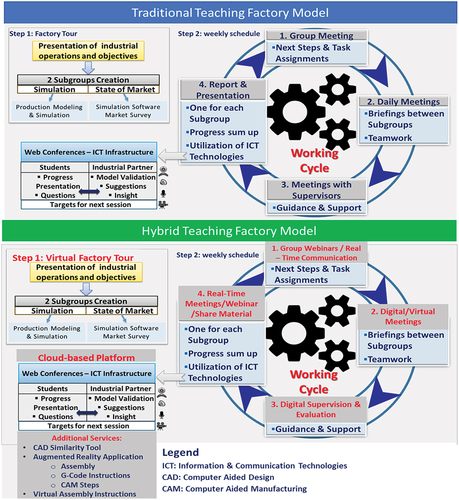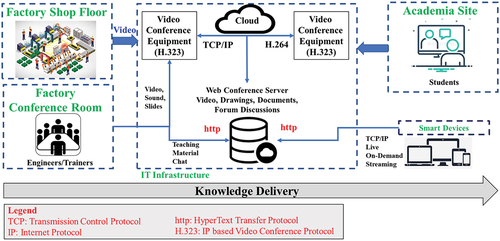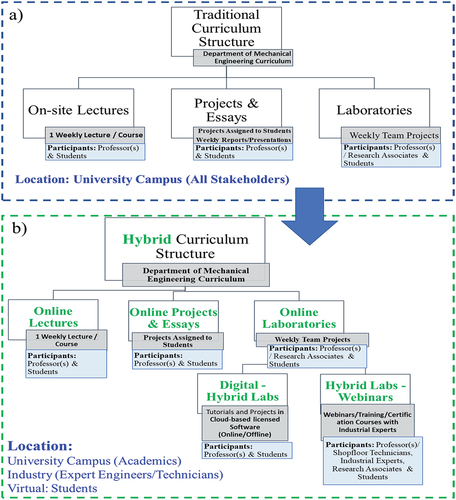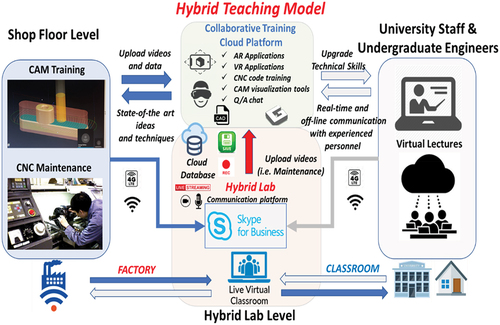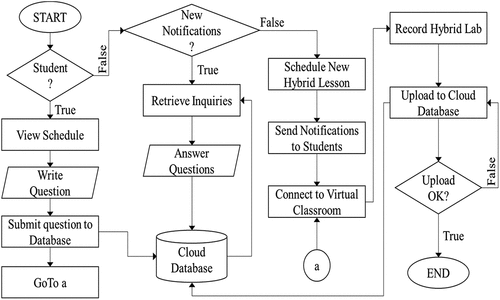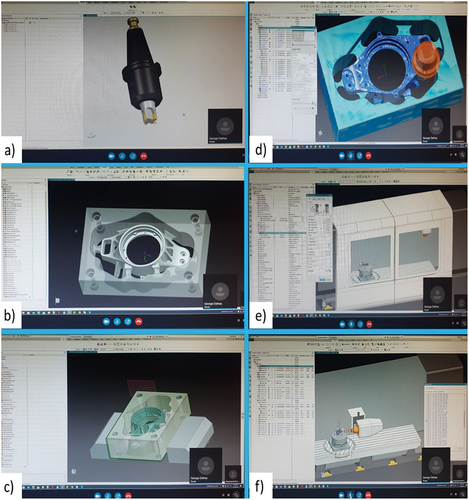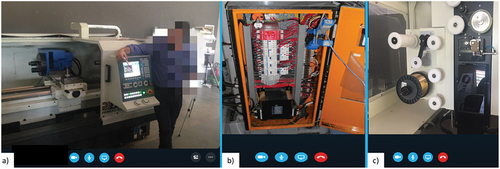ABSTRACT
Hybrid classrooms have become more and more common during the pandemic. Digital technologies have accelerated the transition into the university of the future. Digital Twins technology, one of the trending technologies related to Industry 4.0, helps faculty to create simulation models based on course requirements. Universities are still facing the challenging issue to offer high quality learning opportunities without risking participants’ health. Towards that end, the current study presents a Hybrid Model under the Teaching Factory framework concept that has been successfully implemented and validated. In four hybrid case studies, Engineering students guided remotely laboratory personnel towards a successful manufacture and assembly of a customized projects assignments as well as completed training webinars in the field of Maintenance and Computer Aided Manufacturing (CAM). The results show that pedagogical dimensions were extended. Besides technology, innovative pedagogy, and learning environments, this study added two constructs: sustained support and cyber safety. Collaboration is required at different levels; meanwhile, cyber safety is highlighted to ensure healthy digital learning environments.
Introduction
The recent worldwide socioeconomical developments (including the COVID-19 pandemic) has pushed online learning and digital technology-based teaching to the forefront. Several countries around the world have been experimenting with distance teaching and learning using educational technology as a result of massive lockdowns. Concretely, in China, the Ministry of Education encouraged schools and universities to promote online delivery to replace face-to-face teaching, based on the policy ‘Suspending Classes without Stopping Learning’ (Zhang et al. Citation2020). Similarly in Greece, the Ministry of Education responded to the crisis calling it an opportunity to put forward long-awaited changes aimed at improving the digital skills of the educational community. The crisis has also coincided with providing people, beyond education, with a wide variety of long-overdue online services. However, this shift towards digital education highlighted the significant consequences of the economic crisis. According to OECD (Organisation for Economic Co-operation and Development) data, approximately 20% of Greek students do not have access to a computer, 10% do not have Internet access (OECD Citation2020). Further to that, 33.3% of students complained about the technical and digital skills of their supervisors, during the integration of digital devices in education. Lastly, 40% of Greek students attend schools with a sub-optimal infrastructure for supporting an online teaching/learning platform (McCarthy Citation2020).
Teaching practices have been impacted by the shift from classroom instruction to online teaching (Sun, Franklin, and Gao Citation2015), reshaping pedagogy in educational settings (Assunção Flores and Gago Citation2020). Prior to COVID-19, information, and communication technology (ICT) had expanded technology-based learning activities in networked environments (Marcelo and Yot-Domínguez Citation2018), such as mobile learning (Christensen and Knezek Citation2017), smart learning (Thomas, Parsons, and Whitcombe Citation2019), digital learning (Munro Citation2018), and recently hybrid learning (Mourtzis, Angelopoulos, and Panopoulos Citation2021b). Currently, education is undergoing a technological transformation aimed at hybrid teaching and learning, which emphasizes flexibility, productivity, and connectivity (Benesova et al. Citation2019). A strong adoption of technology is regarded as a critical component in the enhancement of teaching and learning (Cochrane Citation2014). The disruption of traditional education systems due to pandemic inspired pedagogy and has the potential to improve the resilience of current educational systems in an attempt to overcome future digital education challenges (Anderson Citation2020).
Previous research investigated at technology integration in the classroom, blended teaching design (Zhou, Chen, and Chen Citation2019), and technology competency (Farjon, Smits, and Voogt Citation2019). Having identified the abovementioned digital challenges, in this research work a Hybrid Teaching-Learning Cloud-based framework is presented. The applicability of the proposed framework has been validated in four (4) real-life machine shop case studies.
The rest of the paper is structured as follows. Section 2 presents the State of the Art on the Teaching and Learning Factory Models, as well as the State of the Market situation for online education. Section 3 presents the Architecture and the Implementation of the proposed model. Next, in Section 4 four case studies of the proposed Hybrid Teaching model are presented. Finally, in Section 5 conclusions are drawn, and the outlook of the paper is provided
State-of-the-art
The evolution of education vs industry
The Fourth Industrial Revolution 4.0 (I4.0) has significantly affected and changed several aspects of the society. Experts envision a future in which the Internet of Things (IoT) and Artificial Intelligence (AI) connect people through smart devices. This shift towards digitalization leads to new teaching and learning methods that have reshaped the education field. As a result, future education must be aligned with Industry 4.0, so that curriculum is tailored to the individual preferences and interests, educators serve as mentors, and services are provided to activate lifelong learners.
The Industry 4.0 concept introduces new ways of connectivity, and data management (Cloud Technology) as well as new environments for knowledge sharing and training (Extended Reality – XR) that become embedded in manufacturing. This effort reshapes and upgrades current manufacturing machinery to Cyber-Physical Systems (CPS). The same technologies play a crucial role in manufacturing education (Mourtzis, Zogopoulos, and Vlachou Citation2018b). These key enabling technologies enable knowledge to be effectively transmitted to new engineers, increasing their familiarity with them while also creating a more appealing image, resulting to a novel framework for advanced manufacturing education, also known as Education 4.0. This education system creates a sustainable environment that will accelerate its adoption in manufacturing (Andersson and Mattsson Citation2021). In the alignment of industry requirements with the corresponding educational requirements is depicted.
Personalized education
Education was already undergoing digital transformation prior to the pandemic. However, the global health crisis has accelerated the transformation and forced education providers to seek solutions that can ensure learning continuity for all students (Andersson and Mattsson Citation2021). Data-driven adaptation of any aspect of instructional practice to a specific learner’s relevant characteristics is defined as ‘personalized education’. Relevant learner characteristics are any variables that explain variance in learning outcomes. Any interaction between a learner and a teacher that has direct or indirect relevance to the learning process is defined as ‘instruction’ (Tetzlaff, Schmiedek, and Brod Citation2020). One of the most common forms of personalization in digital learning environments is the adaptation of instructional materials to fit the learner’s ‘learning style’ (Kumar and Ahuja Citation2020). The personalized Hybrid Teaching Factory (TF) model in comparison to the Traditional TF Model is shown in and is based on Control System Modelling principles. To meet students’ individual needs, personalized learning is no longer an option but a requirement. Delivering a larger portion of a course virtually frees up time for instructors to spend more time with students one-on-one. This also facilitates instructors to create content that is more tailored to the needs of individual students. Virtual classrooms and Learning Management Systems (LMS) aid in student and faculty engagement and feedback (Fourtané Citation2022).
Consequently, a new paradigm under the name ‘Personalized Perception’ is presented in this research work. This new paradigm allows students and educators to assess individual learning characteristics and, as a result, create adaptable teaching/learning models that consider students’ skills, competences, and interests (Mourtzis, Angelopoulos, and Panopoulos Citation2022a). To summarize, the main goals of the Personalized Perception paradigm are as follows: 1) Creating an educational strategy that is specific to each student’s strengths, needs, skills, and interests. 2) Development of a learning plan based on current knowledge and areas for improvement.
More specifically, Digital Personalized Education refers to online teaching and learning based on digital services and platforms. Next, the factors for efficient online and digital education (Twyman Citation2018): 1) fast and dependable internet connectivity (such as 5 G networks), 2) learning software, 3) digital skills, 4) affordability, and 5) exposure to new technologies and techniques introduced under the framework of Industry 4.0.
It can be stressed out that students are consumers who expect to have their needs met. It is critical for university leadership to understand and respond to what current and future students want from their university experience in order to navigate toward the university of the future (Fourtané Citation2022). Additionally, in Education 4.0, educators’ roles must shift from teacher-centered to student-centered learning. It is critical that students have ICT and collaborative skills, as well as an interest in lifelong learning. Students must also be able to solve critical problems, think creatively, and communicate effectively (Yoke Citation2018). Furthermore, Education 4.0 affects cognitive, affective, and psychomotor domains. Moreover, as per the author in (Gill Citation2017), application, analysis, evaluating, and creating will become far more important in the cognitive domain than lower-level cognitive skills. As a result, education from now on is all about embracing digital technology. Education 4.0, according to (Fisk Citation2017), is personalized, online-based, accessible 24/7 from anywhere, flexible delivery, peer, and mentor-led learning, with a focus on why or where rather than what or how, modular, and project-based, student ownership, and evaluated rather than examined. Higher Learning educators have started using open learning platforms such as Massive Open Online Courses (MOOCs), which can be accessed from anywhere on the internet and offer thousands of courses. The differences between education phases from Education 1.0 to 4.0 have been compiled in .
Table 1. Differences between education phases (Embi Citation2018).
Phygital learning concept
The concept of Phygital Learning is introduced at this Section ‘Phygital’ is a term that refers to the integration of digital elements into the physical environment in order to improve the learner’s experience, and it is derived from the combination of words PHYsical and diGITAL. Education was already undergoing a digital revolution that was transforming its practices even before the COVID-19 pandemic. As a result of the pandemic, education has transformed to a hybrid or phygital mode. Phygital learning can take place anywhere there is network connection. By placing an AR marker on a physical object such as a poster or a board, a traditional classroom can be transformed into a phygital learning environment (Vate-U-Lan, Quigley, and Masouras Citation2016). The steps depicted in , can be described as an 8Cs process for phygital learning: 1) Connection, 2) Captivation, 3) Contexts, 4) Contents, 5) Communication, 6) Collaboration, 7) Consistency, and 8) Competency. Each stage in the smart learning ecosystem will be guided by instructors and students while they are physically present in a specific environment with full functionality of technology that supports each stage.
Figure 3. 8cs Processes of Phygital Learning adapted from (Vate-U-Lan, Quigley, and Masouras Citation2016).
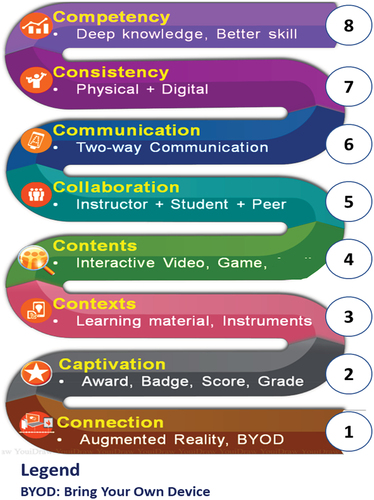
Digital educational research and development (R&D)
Education technologies, as a result of the impact of information and communication technology, pose a threat to the educational system by breaking the limitations of traditional pedagogy. Most aspects of teaching and learning are transferred through networked learning, which speeds up the integration of technology and student-centered pedagogy in the digital era (Daniela, Kalniņa, and Strods Citation2017). In order to understand the principles of the teaching and learning process in a technology-enhanced environment, a focus on pedagogy in the information ecosystem is required (Mourtzis Citation2018). To describe teaching and learning in technology-enhanced environments, three terms have emerged: mobile pedagogy, smart pedagogy, and digital pedagogy. The use of mobile pedagogy as a teaching method has been studied because of its seamless interactions in virtual learning environments (Daniela, Kalniņa, and Strods Citation2017). Smart pedagogy improves teaching and learning through self-monitoring, analysis, and reporting systems, in addition to connectivity and mobility. Smart refers to Education 4.0 technologies that personalize learning and teaching in smart environments (Recalde et al. Citation2020). Smart systems record the educational process and provide optimized models for teaching effectiveness through Smart analysis (Mourtzis, Zogopoulos, and Vlachou Citation2018b). When compared to mobile pedagogy, smart pedagogy allows for more cognitive learning experiences and supports metacognitive development (Kellsey and Taylor Citation2016). The term ‘digital pedagogy’ refers to the use of digital technologies in current and future teaching activities (Daniela, Kalniņa, and Strods Citation2017). Thus, digital pedagogy has expanded to open education as information and communication technologies have advanced, representing the progressive educational technologies of Education 3.0 and Education 4.0. Digital pedagogy is widely used in the formal education system during the COVID-19 pandemic, transforming teaching and learning experiences through online platforms and virtual learning environments (Väätäjä and Ruokamo Citation2021). Furthermore, digital pedagogy has enabled online, blended, and face-to-face learning environments, according to (Lewin and Lundie Citation2016). As a result, the term digital pedagogy should not be defined solely in terms of the use of digital tools.
Internet of things (IoT) technologies for future education
The need for ‘Hybrid classrooms’ to meet the ever-growing demands of the education sector has been highlighted by the pandemic situation. Hybrid classroom solutions have the potential to provide with lifelong access to new knowledge and skills. Digital technologies were given special attention in order to keep the process running smoothly during difficult times. Digital Twin (DT) technology (Stavropoulos and Mourtzis Citation2022) is one of the pillar technologies of Industry 4.0 (Rüßmann et al. Citation2015) and can be considered as crucial in the new models of education. Educators and students, who are the main stakeholders in education, can benefit from the DT technology to a greater extent. The application of DT begins with curriculum design and extends to all aspects of the teaching-learning process. It could be used in curriculum design to keep content up to date. More specifically, it helps to create practical simulation models based on course requirements. According to (Meenakumari Citation2021), simulation-based learning (SBL) has aided students in the following areas: a) Increased motivation, and b) self-responsibility for learning, peer learning. Thus, SBL has improved content delivery and the usage of technology for teaching, its ease of demonstration, and also aided in student assessment from the teachers’ perspective. Finally, SBL also aids in the re-creation of the communal classroom experience through more improvised classroom engagements.
The stakeholders believe that DT technology can help bridge the gap between the digital and physical worlds by providing timely access to physical system data and preventing problems before they arise. In addition, this technology could provide an alternative to uninterrupted education services and even aid in the development of new educational strategies and plans. DT technology can be used in the classroom for experimental and experiential learning. This technology could be used to better understand the structure of a system. A DT can also be used in the laboratory to investigate the behaviour of the system and the limitations under various simulated conditions. It is observed that students can learn and understand system behaviour more quickly in a controlled, simulation-driven environment because the virtual representation used in a DT makes it easier to manipulate than its physical counterpart. Students can also use the DT to run simulations to investigate system behaviour under a variety of what-if scenarios, learn about failure modes, and develop an understanding of system sensitivities to changes in various system parameters and external disruptions (Mourtzis et al. Citation2022b). This knowledge aids in the reduction of system downtime and the improvement of system throughput.
Teaching factory model
The Teaching Factory Concept (TF) is based on the notion of the triangle of knowledge (Chryssolouris et al. Citation2006; Chryssolouris, Mavrikios, and Rentzos Citation2016). This concept has its origins in the discipline of the medical sciences and specifically in the teaching hospitals paradigm. TF concept connects industry with the classroom to achieve bi-directional knowledge exchange using Information and Communication Technologies (ICTs). This two-way channel of knowledge transfer includes two different modes of operation at the Teaching Factory, namely those of ‘factory-to-classroom’ and ‘lab-to-factory’ (Mourtzis et al. Citation2018a; Mourtzis, Zogopoulos, and Vlachou Citation2018b). Stavropoulos et al. in their research work (Stavropoulos, Bikas, and Mourtzis Citation2018) discussed how the introduction of CPS and Industry 4.0 technology can reshape manufacturing training under the framework of Teaching Factory (TF), addressing the growing need for highly skilled workers. Next, a framework for collaborative industrial based teaching and training to engineering students and providing engineering solutions to enterprises through the TF paradigm is presented in (Mavrikios et al. Citation2013). Furthermore, the Teaching Factory Network (TFN) will bring together industrial (factories) and academic (classroom) actors and facilitate the launch of collaborative production training projects of mutual business interest (Mavrikios, Georgoulias, and Chryssolouris Citation2018). The Information and Communication Technology (ICT) Configuration of a Teaching Factory Project is presented in . More specifically, the proposed system consists of clients (i.e. Factory Shop Floor technicians, Expert Engineers from the Factory Conference Room, and the Academics as well as the students) that connect to the platform through a variety of mobile devices, on demand or live, and a Cloud platform that manages all necessary data and serves as a server. The novel aspect of the suggested framework is the notion that a group of student engineers can work together in real-time to design a new product, share important information about the design process without running the risk of losing it, and use cutting-edge AR technology to get a vivid visualization of the idea. The Cloud platform is the most important component of the suggested solution because it is responsible for most of the actions carried out during the collaborative TF project. The main usage of the Cloud platform is for managing and disseminating the data required for product design projects, specifically the 3D CAD geometry and communication between collaborating engineers using text that might be structured or unstructured. As a result, a specific directory in the domain is automatically established for each new product. This aids in maintaining the organization of all the project-related information. Finally, a group of communication protocols called Transmission Control Protocol/Internet Protocol (TCP/IP) are used to connect network devices on the internet. TCP/IP provides end-to-end communications that specify how data should be divided into packets, addressed, transferred, routed, and received at the destination. This defines how data is exchanged over the internet. TCP/IP is intended to make networks dependable by enabling networks to automatically recover from the failure of any device on the network with minimal central management requirements.
Learning factory model
Learning Factory (LF) as a subset of the Teaching Factory, is a concept relying on the utilization of university equipment, along with manufacturing facilities resembling the industrial environment inside the university campus. Furthermore, people from both academia and industry, are participating in specified courses in an attempt to promote new manufacturing concepts, trends, and knowledge in the academic environment. While several LF have been established in industry and academia over the last decades, a detailed science analysis of the topic is still lacking (Chryssolouris et al. Citation2006). The goal of the researchers in (Abele et al. Citation2017) is to close this gap by developing the state of the art of learning factories. The motivations, the social context as well as the educational structures of LF are highlighted. Definitions of the term LF and the corresponding morphological models are also discussed. Nevertheless, the need for a new generation of engineers, Generation 4.0 Engineers, arises for a productive transition to digitalization. The Academia will also provide Generation 4.0 Student Engineers with advanced knowledge, skills, and hands-on experience. Therefore, it becomes apparent that the adoption of the LF paradigm is a promising solution. Consequently, within the LF concept, the design and construction of a fully automated and flexible manufacturing cell is presented in (Mourtzis, Zogopoulos, and Vlachou Citation2018b). Participating students under the supervision and guidance of senior engineers are divided into groups, each one being responsible for designing and developing one of the system components and then combined in order to form the final solution.
State-of-the-market
UNESCO has provided an extensive range of distance learning options, including instructional applications, networks and tools aimed at empowering parents, teachers, educators, and school administrators for the promotion of e-learning, and provision of social support (ITU News Citation2020). While these solutions do not have the explicit approval of UNESCO, they tend to have a broad reach, a strong user base and evidence of impact. They are classified based on distance learning requirements, but most of them provide flexibility across several categories as follows: 1) Resources to provide psychosocial support, 2) Digital learning management systems, 3) Systems built for use on basic mobile phones, 4) Systems with strong offline functionality, 5) Massive Open Online Course (MOOC) Platforms, 6) Self-directed learning content, 7) Mobile reading applications, 8) Collaboration platforms that support live-video communication, 9) Tools for teachers to create of digital learning content and 10) External repositories of distance learning solutions (McCarthy Citation2020). Furthermore, pandemic has become a catalyst for educational institutions around the world seeking innovative solutions in a relatively short time. To that end, in order to slow the spread of the virus, students in Hong Kong started learning through interactive apps at home in February (BBC News Citation2020). Additionally, 180 million Chinese people gained access to learning material through live television broadcasts. More analytically, a new national cloud learning platform (Qu Citation2020) has provided online study resources for both junior and senior high school students while at the same time, educational content for elementary school students was broadcasted on national television (Tam and El-Azar Citation2020). According to CCTV News, for the first week 169 lessons were launched on the national cloud learning platform, covering 12 subjects for junior and senior high school based on the national curriculum. The national broadcaster added that the materials will be supplemented by key teachers from Beijing and some other cities. The Ministry of Industry and Information Technology also roped the e-learning platform with 7,000 servers and 90 terabytes of bandwidth in the three major telecommunications operators, 1) China Mobile, 2) China Unicom and 3) China Telecom and tech companies like Baidu, Alibaba, and Huawei as well (Dai Citation2020).
However, there are some countries that offered e-learning as a major alternative way before the COVID-19 outbreak. One indicative example is India which has more than 15 open universities and 110 dual-mode universities offering distance education. During the period of the Covid-19 outbreak, the government also allowed the top 100 Indian HEIs to provide fully online degrees (Brody Citation2020). One fascinating approach that India uses to provide distance learning is the Study Webs of Active Learning for Young Aspiring Minds (SWAYAM) network, which aims to provide access to Massive Open Online Courses (MOOCs) and other e-learning material produced by various educational providers. In addition to the India case, a similarly efficient online system has been established in Finland. The national policy framework emphasizes equality and quality education for all, and national universities and applied sciences offer Open Studies courses that are open to all, regardless of education and age (Brody Citation2020). Next, Nordic countries to support online learning have summarized over forty (40+) solutions from Estonia to Denmark that can be used for free (Education Nation Top Remote Learning Solutions Citation2020). It must be mentioned that Finland developers have contributed once again in this effort towards digital and e-learning solutions. More specifically, Koulou.me offers free applications and resources to support distance learning during the pandemic (Koulu.me Right to education Citation2020). Last but not least, it is stressed out that Digital Pathways and The EdTech Hub examine the key constraints of using EdTech on a scale in a time of crisis and highlight the opportunities that have so far emerged in a rapidly changing context. Evidence and examples are provided to inform policy and programming decisions in Remote Learning and COVID-19 (Mourtzis, Siatras, and Angelopoulos Citation2020a). The Organization for Economic Co-operation and Development (OCED) has predicted a decline in economic growth from 2.9% to 2.4% in 2020 and cautioned that economic growth could also hit nearly 1.5% if the pandemic continues (OECD Citation2020).
Distance learning has become the most effective option, so that higher education institutions are capable of constantly delivering high-quality teaching and maintaining consistent communication with students. Several campuses, in particular ETH Zurich (ETH Citation2020), EPFL (EPFL Citation2020a), and Imperial College London (Imperial College London Citation2020a) had accepted more restriction relief and are in the process of slowly reopening campus houses, facilities and laboratories. In some cases, such as in EPFL (EPFL Citation2020b), the summer exams will be conducted in person, as well as in Cambridge University (University of Cambridge Citation2020), and Cranfield University (Cranfield University Citation2020), for some subjects. The majority of top global institutions followed a hybrid educational model for the Fall 2020–2021 semester, which is a mix of online and in-person learning such as Columbia University (Columbia Community Citation2020), Stanford University (Stanford University Citation2020), MIT (MIT News Citation2020) and Imperial College London (Imperial College Citation2020b).
Proposed architecture of the hybrid teaching model
The ability of universities to adapt to 21st-century skills will determine the workforce of the future. Critical thinking, communication, collaboration, and a growth mindset are characteristic examples of such abilities. The scope of this research work is the design and development of a Hybrid Teaching Model in order to continue without lecture post-ponements or courses losses, based on the official curriculum of the Mechanical Engineering Department. Hybrid teaching model combines online and face-to-face teaching into one cohesive experience at an equal ratio (50–50). A lot of preparation is required to ensure that hybrid works well, allowing the two formats to capitalize on the strengths of each other. Furthermore, as per the (Ortiz et al. Citation2021) a conceptual framework for the design and implementation of hybrid models in the context of the COVID-19 pandemic is discussed. Four pillars for technology usage in education and new experiences during the school closure are identified, in particular 1) new pedagogies, competencies, and teacher profiles; 2) equipment and connectivity; 3) platforms and content; and 4) data and monitoring of students.
Social distancing rules would influence the number of rooms in the fall semester; thus, students are suggested to register in order to ensure an equitable arrangement for face-to-face courses. The rest of those taking the course, when they do not attend the class in person, will interact with a live stream or a recorded lecture. The number of the face-to-face lectures through the semester is depended on the available classrooms and laboratory rooms. The proposed Hybrid Model is a conceptual framework so that it can be applied using the current course management system and the free online resources that are provided by the University. Although lectures, based on the curriculum are allocated to a classroom, all lectures will be delivered both online (Students) and in a physical space (Teaching Staff and a group of students). The Traditional Curriculum Structure of the Department of Mechanical Engineering and Aeronautics is presented in , and the Hybrid Teaching-Learning Adapted Curriculum Structure is presented in .
Towards a modular implementation framework for hybrid education
The developed hybrid education model is built is structured around ten components or modules which are listed and explained as follows:
Connectivity: The internet is a fundamental tool for implementing effective education models into practice. Undoubtedly, one of their biggest challenges during the pandemic was the gap in access to Internet. Free access to educational platforms and websites is one of the most frequently employed techniques. These types of agreements ensure basic access to certain materials and content, but they do not address access to other resources and tools, such as access to audiovisual content or other content platforms that are frequently used for teaching, or videoconferences between students and teachers.
Physical Infrastructure and Technology: Access to digital infrastructure and connectivity, is a prerequisite for putting hybrid educational models into practice. Devices should be chosen carefully, considering the age and the academic level of the students. Tablets are typically advised for younger children as they are better for touch-based exploration and discovery, but computers offer more advantages in terms of fostering curiosity and creativity while also assisting in the growth of other skills like programming and robotics.
Curriculum Adaptation: Curriculum adaptation is a critical step in ensuring a genuine change of education systems that prepares students for the future. Implementing efficient hybrid education models must be supported by a process of curriculum modification focused on competencies and skills, eliminating pedagogical approaches based on repetition and memorization of a wide variety of knowledge.
Pedagogical Practices: The use of technology in education, as well as the complementarity of distant and face-to-face learning spaces, opens new possibilities for personalizing education and making learning more attractive. Educators have to be trained not only to use technology, but also to use it to foster students’ acquisition of skills, such as critical thinking, teamwork, and flexibility, by incorporating new sources of learning and creating personalized, relevant, and student-centered experiences.
Human Resources: Training in new pedagogies, skills, and digital competences for management and ministerial teams is required to accompany and advise educators in the transformation of teaching and learning processes.
Digital Content Platforms: Digital platforms are an important tool for hybrid education models because they assist material distribution, skill development, strengthening links between students and teachers in remote education, and learning monitoring.
Flexible Incorporation and Graduation Modalities: Tools for identifying students at danger of dropping out, as well as efforts to retain them in the system until they complete their studies, must be included in hybrid education models.
Skill Certification: Skill certification is critical for increasing young peoples` labour market integration because it allows to identify the exact skills they need to learn. Hybrid approaches necessitate more robust and diverse instruments for measuring learning. This entails developing systems for young people to demonstrate the abilities they have gained, which have previously not been measured yet are now essential for both entry to higher education programs and inclusion in the labour market.
Educational Management and Financing: The digital transformation of Education Managerial and Information and Systems yields several management and financial benefits such as: 1) resource allocation, 2) optimization of human resources time due to digitization of administrative tasks, and 3) budgetary savings thanks to efficiency gains as a result of the availability of high-quality information and time savings.
Technological Ecosystem: To foster the development of a high-impact digital education ecosystem, it is critical to promote strategic dialogue among the region’s education authorities in order to share good practices and experiences and define strategies and action plans on key issues for hybrid education, such as access to connectivity and devices, teacher training, new pedagogical practices, and curriculum adaptation.
This Hybrid Model was applied to a group of fifty-five (55) students who attended the Computer Numerical Control (CNC) course. The architecture of the proposed Hybrid Model is presented in . The backend tool of the proposed Hybrid Model is a cloud platform that can be used by the young engineers and the experiences engineers from the partner industries. The University supervisors (i.e. Professors, Teaching Assistants, and technicians) can be logged in both as administrators and users. The collaborative Cloud Platform that can be considered as an extension of the research work presented in (Mourtzis, Siatras, and Angelopoulos Citation2020a), offers a list of software tools as a service. More specifically, the students can improve their digital skills through the offered state-of-the art digital technologies such as Augmented and Virtual Reality. Moreover, useful educational and industrial material related to CNC lectures is offered (i.e. CNC code training via online compilers) as well as a Questions and Answers Chat Box for bi-fold knowledge and experience transfer. In parallel with the Training Services offered via the collaborative platform, Virtual Lectures take place on a weekly basis. At the same time, the University Staff, organize Virtual Lectures under the Factory to Laboratory Concept with expert technicians in the field of CNC. More specifically, two Hybrid Laboratory Lectures were organized as real-life case studies (see ).
The first case study was focused on the Computer Aided Manufacturing (CAM). The presenter of this Hybrid Laboratory was a Mechanical Engineer working in a state-of-the-art manufacturing unit that specializes in the design and manufacturing of innovative injection molds, progressive cutting and & forming dies. The participants consisted of the under-graduate engineers and the University supervisors. The second case study was focused on the CNC Maintenance field, where expert technicians presented in real-time the main maintenance steps of a 3-axis CNC milling machine. The third case study was focused on CNC training, and especially in the G-code explanation and the Numerical Control Controller. The final case study presents a hybrid laboratory (i.e. assembly of a customized radio-controlled car) among the Professors and the Research Associated of the Lecture entitled ‘Manufacturing Systems: Theory and Practice’ and the Students.
The real-time communication platform that was used for both hybrid meetings was the Skype for Business application. Each hybrid laboratory was recorded and uploaded to a Cloud Database to be open accessed to gain insights and extract useful conclusions based on the Q/A (Questions and Answers) chat communication box and the recorded real-time communication between the experienced engineers and the participants. The flowchart of the proposed hybrid model is presented in . The Cloud platform proposed in this manuscript resembles an online workspace for students, on which a series of services are stored. According to the Flowchart of the student can log in to the Cloud platform, to check the Schedule of the upcoming Virtual Classrooms, to post a question which will be stored to the Cloud Database for future reference and find relevant answers. If inquiry retrieval is not necessary, the student may connect to the scheduled virtual classroom or watch on demand material, upload his report/assignment to the Cloud database and communicate with either the expert technicians or his supervisors from the Academia.
Case Studies
Case study 1: computer aided manufacturing (CAM) with NX siemens for 3 axis part
A ‘factory-to-classroom’ operating scheme, involving the implementation of an industrial-driven project, was envisioned to validate the proposed Hybrid-Teaching model. The aim of this pilot was to introduce, validating the system, a Hybrid Teaching Factory between an academic (i.e. Supervisors and Student Engineers) and an industry partner (i.e. Expert CAM engineer). The role of the academic partner was undertaken by the Academic Stakeholder, while the role of the industrial partner was undertaken by an SME that specializes in injection molds, progressive cutting and forming dies. The main scope of this virtual teaching and training meeting was to introduce the young engineers to the Computer Aided Manufacturing (CAM) technology under real-life industrial applications. In , six screenshots of the NX Siemens Software are presented. At first, the CAM engineer explained to the student engineers the Milling cutters. Next, the differences between the Face Mills and the End Mills were analyzed and finally as presented in , a Plunge and profile inserted milling cutter was selected. Next, the CAM engineer explained the main CAD/CAM process steps to generate the G-Code. In , the Design Part and the transparent Design stock are presented. Moving on, in , fitting techniques to the machine tool table were presented. As the stock is clamped on the CNC machine table, the CAM engineer visualized the simulation path (). Additionally, the CAM engineer visualized the CNC Milling Machine () as well as Tilting head examples (). By the time the first six steps were presented and discussed, the CAM Engineer selected and presented some complicated CAM procedures that required hands on experience and expert CAM skills. More specifically, as illustrated in , the young engineers had the opportunity to observe in real time a Tilting Head with Rotary Table Example to create radius in difficult areas of the desired product (). Furthermore, the mirroring process was presented based on young engineers’ questions related to techniques to save time and effort ().
Figure 9. CAM Hybrid Lab – a) Tilting Head with Rotary Table Example, b) Mirroring for similar products.
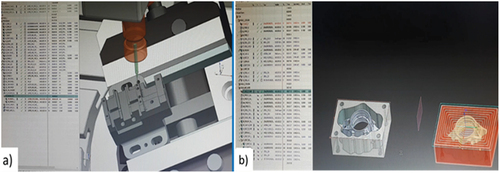
Education 4.0 includes online assessments, robotics, Artificial Intelligence (AI), big data, Virtual Reality (VR), Augmented Reality (AR), and virtual environments and platforms as tools to replace the traditional old procedures of obsolete conventional education through creativity and student centricity, with personalization as a key component. In order to continue generating successful graduates, universities must prepare their students for a world in which CPS are prevalent across the industrial landscape. This entails teaching students about this technology and integrate these technologies as part of the curriculum, altering the approach to learning entirely, and utilizing this technology to enhance the university experience. With the provision of the cloud-based hybrid TF platform, implemented during the CAM case study, young engineers had their own access to information, the ability to learn virtually, and platforms to easily connect with faculty and expert engineers in live or on-demand sessions to acquire digital knowledge. Thus, with the provided case studies, relevant courses from the curriculum (e.g. Into to Manufacturing Systems, CAD/CAM, CNC etc.) were no longer centered on a back and forth between young engineers and Supervisors, but rather on a more networked approach, with students having their own direct connection to a variety of different information sources.
Case study 2: CNC maintenance
Proper maintenance of the CNC machines will save time in production and avoid failures in machines. CNCs are advanced machines which are able to facilitate the most complex machining tasks. As such, to maximize output, CNC machines must be properly maintained by human operators. Otherwise, most components are subject to premature wear and tear. However, as modern machinery is becoming more complex, maintenance must be carried out by experienced and well-trained personnel, while overseas support is timely and financially costly. To that end, cutting edge digital technologies such as Augmented Reality can facilitate the development of maintenance support tools covering only a limited number of maintenance scenarios. An interesting research work addressing this literature gap with the design and development of a framework for real time remote maintenance support and repair operation based on AR between the shop floor technicians and the production engineers is presented in (Mourtzis et al. Citation2020b). Following this real-time communication for training purposes, the second case study was focused on the CNC Milling machine operation and maintenance tasks. As presented in , during the second hybrid lab the young engineers had the unique opportunity to watch in real-time the G-Code Programming via the NC Controller ( a) as well as the maintenance process step by step in both electrical and mechanical components of the CNC Machine.
Case study 3: CNC training
In continuation to the Case Study, presented in the previous paragraph, additional remote training courses have been executed. More specifically, in these courses, the industrial partner, has guided in real-time the students through the setup of CNC milling machine operations, the generation of the G code, the setup of the end mills (cutting tools), and the machine properties. However, in order to facilitate the students, get accredited for their participation in the online courses, a blockchain-based platform has been utilized (). The platform supports the creation of a virtual/digital wallet, as presented by Mourtzis et al. in (Mourtzis et al. Citation2021c), and the functionality of the platform is extended with the provision of a stand-alone application, compatible with Smart Devices (e.g. Android devices) and PCs.
Figure 11. A) Blockchain platform Graphical User Interfaces (GUI) b) CNC milling machine controller c) Engineering instructor live course.

The developed application consists of several graphical user interfaces (GUI) so that the users can see their information, their digital wallet, the recent activity of their account and the progress of their account over time. An additional interface entitled ‘My Contracts’ has also been implemented, in order to enable the users view a list of their ongoing contracts. Upon the successful completion of the above-mentioned CNC courses, the students are rewarded with academic credits (i.e. ECTS, bonus for grades, subscriptions for webinars etc.), and they also get a digital certification.
Case study 4: virtual assembly assisted by augmented reality
This case study involved a ‘real-life’ engineering challenge to be elaborated by engineering students under the supervision of the University Professors and technicians. Twelve teams were formed, each consisting of 18–20 student engineers. Each team developed its own process planning, scheduling, and simulation process during the Semester via Hybrid Laboratories and via the Collaborative Platform provided by the Laboratory. The Teaching Factory pilot was conducted in separate sessions for each team, where the student teams interacted with the expert engineers using video conference tools (i.e. Skype for Business) and guided them to complete the final assembly of their personalized remote-control car. A Figure of the Real-Time Assembly of the Teaching Factory pilot application is presented in . The Graphical User Interface (GUI) is presented in and in a screenshot of the technician’s field of view during the live assembly session is presented.
Figure 12. A) Main Menu GUI b) AR assembly GUI c) Real-time Remote-Control Car Assembly, and d) Real-time Technician’s Field of View.
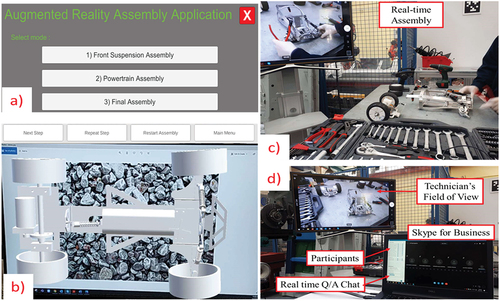
Virtual education is a general term for online teaching and learning with the aid of digital services and platforms. Efficient online education relies on factors such as fast and reliable internet connectivity, learning software, digital skills, affordability, and exposure to technology. The applicability of the proposed Hybrid Teaching-Learning Model has been validated at a University based machine shop. More specifically, the following presented ‘Laboratory to House’ model developed to successfully complete the laboratory courses of the Manufacturing Technology course according to the Mechanical Engineering and Aeronautics Department curriculum. The object of this project was to assemble a Radio Controlled (RC) Car that was designed within the semester. The proposed framework consists of a Cloud Platform that acts as a server and handles the needed data and the ‘clients’ (University Supervisors and Students) who can connect to the Collaborative Cloud Platform through smart devices (i.e. personal computers, tablets, smartphones and so on). The proposed system architecture has been described in the context of Learning Factory in (Mourtzis, Angelopoulos, and Panopoulos Citation2021b). The contribution of this research work is focused on the provision of a framework which enables the collaboration between student teams, providing additional functionalities for designing solutions, exchange files and communicate for their assigned project in real-time. Moreover, a set of services is offered through the Cloud Platform such as Virtual (VR) and Augmented Reality (AR) applications for the visualization of the final 3D design as well as a similarity tool for comparing CAD Files.
Evaluation of hybrid teaching method
The comparison between the performance of the students in each case study and the overall positive outcome of each case study are summarized in . With the proposed Cloud Platform, the students were able to increase their final grades by 10–15% in comparison to the traditional methods, increase their digital skills as well as to enrich their curriculum vitae with certifications and ECTS in their virtual wallets.
Table 2. Evaluation of Case Studies.
Conclusion & outlook
Clearly, the pandemic has utterly disrupted the global education system. The negative effects of the global pandemic emphasized that education systems continue to concentrate on conventional academic skills and rote learning, rather than on skills such as critical thinking and adaptability. The paper emphasizes the need to implement digital technology and collaborative online platforms in education as a way to eliminate the effects of the current Coronavirus pandemic. This is achieved through a Hybrid Teaching-Learning Model that ensures the bi-fold knowledge and experience transfer between the industry and the academia even during the lockdown period. The real-life case studies proved that digital technology offers the possibility to maintain a high level of lectures. Moreover, the young engineers had the unique opportunity to participate and communicate in real-time in two training courses in the field of CAM and CNC technologies. Additionally, the education material from these hybrid laboratories has been uploaded to a cloud database and can be accessed both by the supervisors and students to gain useful insights. Last but not least, through this unprecedented situation many Universities will adopt such Hybrid teaching models beginning from the new academic year.
While disruption approaches due to unexpected lockdowns have been creative and responsive, the fact remains that some education institutes are better equipped than others to take advantage of resources, technical infrastructure and the education technology market to respond more efficiently and comprehensively to the crisis. The emphasis on virtual learning can exacerbate established educational inequalities, especially in developing environments where access to digital technology and stable Internet connections are limited. Especially at this time period where the global economy has been affected, thousands have lost their jobs and the economic future is unstable, the digital divide and the inequalities could broaden. Access to distance learning can be hindered by disabilities or family income. Distance learning does not require educators to play an important role in learner socialization and the provision of social services. As it is obvious, the shift towards entirely digital learning solutions hinders limitations. The most indicative are summarized as follows: a) The move to ‘out-of-school’ education will exacerbate already weak systems of education management and data collection, b) Most of the curricula cannot be easily adjusted to online education and students face the uncertainty that they do not know how their academic year will progress, c) Many students do not have a suitable learning environment at home, and d) The educators’ willingness to adapt and provide education remotely will vary considerably.
The global pandemic emergency was a unique opportunity for change in education on a global scale which has never been seen before. The following section summarizes important positive opportunities and major educational problems that have arisen since the pandemic started. The novelty of the current research work lies in the fact that many of the following challenges can be addressed with the proposed hybrid teaching model (Fourtané Citation2021).
It is a unique opportunity for research staff (i.e. Professors, Researchers etc.) and participants (students) to develop stronger connections and to actively collaborate with one another.
There are unprecedented opportunities for collaboration, innovative approaches, and a desire to learn from others and use different strategies. Most educational related organizations offer their free tools (i.e. Skype for Business) and solutions to help and support both partners. Therefore, as presented in the current research work, it is a unique opportunity to upgrade the digital and presentation skills.
Students now have the flexibility and freedom to take control of their learning and explore as never before new ideas and experiences. Now that students are not tightly monitored within a rigid system, new interests and passions will emerge for many students and educators.
Simulation and digital twins in the classroom
During the pandemic, hybrid classrooms have become increasingly popular. The transition to the university of the future has been accelerated by digital technologies. Faculty can use DT technology, which is one of the pillars in Industry 4.0, to create simulation models based on course requirements. The use of DT technology allows for a truly immersive learning experience. Students can learn highly engaging tasks that are dangerous, complex, or expensive for the classroom by using a DT. Faculty and university staff are familiar with terms like Digital Transformation, Education 4.0, Automation, Artificial Intelligence (AI), Virtual (VR) and Augmented Reality (AR), robotics, 3D-printing (3DP), AI chatbots, Virtual Environments, and DT (Mourtzis Citation2020). Faculty can achieve a maximum level of engagement by using DT in an Augmented Reality (AR) or Virtual Reality (VR) simulated learning experience, allowing each student to learn abstract concepts in their own unique way and much faster. Students can better explore system behaviour under various conditions, understand failure, and develop an understanding of system sensibilities, as well as how changes in system parameters and external disruptions affect the results, by running simulations (Mourtzis et al. Citation2020b). Simulation and DT Services have already been incorporated into the teaching curricula at some universities. Several projects at Stanford University have used DT technology in architecture, construction, and engineering. DT content has been integrated into the teaching curricula at the Copenhagen School of Marine Engineering and Technology Management because they believe it is the reality of the industry. Overall, using DT technology in higher education increases student motivation, facilitates, and accelerates understanding, and enhances the learning experience. Furthermore, industry encourages universities to use pedagogical DT in automation to provide students with a basic understanding of the tools and skills they will need in the future.
Future of higher education with automation
During the pandemic, digital transformation of educational institutions advanced automation in unprecedented ways. In education, automation has a clear goal: to reduce manual labour in repetitive tasks so that faculty and administrators can focus on teaching and on their students. Some areas where automation cannot replace in higher education instruction are listed below (Fourtané Citation2022, Citation2021): a) Mentorship and leadership, b) Innovation and creativity, c) Socializing, d) Teamwork and Collaboration, and d) Reputation and accomplishment
Acknowledgment
The work presented in this manuscript has been partially supported by the Research Council of the University of Patras.
Disclosure statement
No potential conflict of interest was reported by the author(s).
References
- Abele, E., G. Chryssolouris, W. Sihn, J. Metternich, H. ElMaraghy, G. Seliger, G. Sivard, W. ElMaraghy, V. Hummel, M. Tisch, and S. Seifermann. 2017. “Learning Factories for Future Oriented Research and Education in Manufacturing.” CIRP Annals 66: 803–826. doi:10.1016/j.cirp.2017.05.005.
- Anderson, V. 2020. “A Digital Pedagogy Pivot: Re-Thinking Higher Education Practice from an HRD Perspective.” Human Resource Development International 23 (4): 452–467. doi:10.1080/13678868.2020.1778999.
- Andersson, P., and L. G. Mattsson. 2021. “Future Digitalization of Education After COVID-19.” https://www.hhs.se/en/research/sweden-through-the-crisis/future-digitalization-of-education-after-covid-19/
- Assunção Flores, M., and M. Gago. 2020. “Teacher Education in Times of COVID-19 Pandemic in Portugal: National, Institutional and Pedagogical Responses.” Journal of Education for Teaching journal of Education for Teaching 46 (4): 507–516. doi:10.1080/02607476.2020.1799709.
- BBC News. 2020. “Keeping Kids Learning During a Coronavirus Outbreak.” https://www.msn.com/en-sg/news/other/keeping-kids-learning-during-a-coronavirus-outbreak/vi-BB10dVOI
- Benesova, A., M. Hirman, F. Steiner, and J. Tupa. 2019. “Requirements for Education 4.0 and Study Programs Within Industry 4.0.” In Proceedings of the international conference on industrial engineering and operations management, 23–26. http://ieomsociety.org/pilsen2019/papers/358.pdf
- Brody, R. 2020. “Creating Inclusive Learning Environments for Students with Learning Differences from Marginalized Communities.” World Education Blog. https://gemreportunesco.wordpress.com/
- Christensen, R., and G. Knezek. 2017. “Readiness for Integrating Mobile Learning in the Classroom: Challenges, Preferences and Possibilities.” Computers in Human Behavior 76: 112–121. doi:10.1016/j.chb.2017.07.014.
- Chryssolouris, G., D. Mavrikios, N. Papakostas, and D. Mourtzis. 2006. “Education in Manufacturing Technology & Science: A View on Future Challenges & Goals.” In Proceedings of the International Conference on Manufacturing Science and Technology Inaugural Keynote, Melaka, Malaysia.
- Chryssolouris, G., D. Mavrikios, and L. Rentzos. 2016. “The Teaching Factory: A Manufacturing Education Paradigm.” Procedia CIRP 57: 44–48. doi:10.1016/j.procir.2016.11.009.
- Cochrane, T. D. 2014. ”Critical Success Factors for Transforming Pedagogy with Mobile Web 2.0.” British Journal of Educational Technology 45 (1): 65–82. 01384.x. doi:10.1111/j.1467-8535.2012.01384.x.
- COVID-19 Resource Guide for the Columbia Community. 2020. “Journalism School Describes Plan for ‘Hybrid’ Instruction in the Fall.” https://covid19.columbia.edu/news/journalism-school-describes-plan-hybrid-instruction-fall
- Cranfield University. 2020. “Information for Our Prospective Students Arriving in 2020.” https://www.cranfield.ac.uk/about/coronavirus/information-for-prospective-students
- Dai, S. 2020. “With Schools Remaining Closed During Coronavirus Outbreak.” China launches national remote learning platforms, South China Morning Pos. https://www.scmp.com/tech/policy/article/3050940/schools-remaining-closed-during-coronavirus-outbreak-china-launches
- Daniela, L., D. Kalniņa, and R. Strods. 2017. “An Overview on Effectiveness of Technology Enhanced Learning (TEL).” International Journal of Knowledge Society Research (IJKSR) 8 (1): 79–91. doi:10.4018/IJKSR.2017010105.
- Embi, M. A. 2018. “Education 4.0. Presented at the Workshop of the Educator 4.0 in Universiti Malaysia Kelantan, Kota Bharu, Kelantan.” July 29.
- EPFL. 2020a. “EPFL Will Finish Semester Online and Hold Exams in August.” https://actu.epfl.ch/news/epfl-will-finish-semester-online-and-hold-exams-in/
- EPFL. 2020b. “New Directives of 1 July.” https://www.epfl.ch/campus/security-safety/en/health/coronavirus-covid19/gradual-reopening-of-the-epfl-campuses-and-other-sites/
- ETH Zurich. 2020. “Services and Resources, Coronavirus COVID-19.” https://ethz.ch/services/en/news-and-events/coronavirus.html
- Farjon, D., A. Smits, and J. Voogt. 2019. “Technology Integration of Pre-Service Teachers Explained by Attitudes and Beliefs, Competency, Access, and Experience.” Computers & Education 130: 81–93. doi:10.1016/j.compedu.2018.11.010.
- Fisk, P. 2017. “Education 4.0 the Future of Learning Will Be Dramatically Different, in School and Throughout Life.” https://www.thegeniusworks.com
- Fourtané, S. 2021. “Future of Higher Education: Automation to Better Assist Instructors.” Fierce Education. https://www.fierceeducation.com/technology/future-higher-education-automation-better-assist-instructors
- Fourtané, S. 2022. “Preparing for the University of the Future.” Fierce Education. https://www.fierceeducation.com/technology/preparing-university-future.
- Gill, H. 2017. “The Future of Education, How Schools and Universities Can Better Prepare People for the Modern Working Landscape.”
- Imperial College London. 2020a. “Coronavirus (COVID-19) – Updates and Guidance.” https://www.imperial.ac.uk/about/covid-19/restarting-research/
- Imperial College London. 2020b. “Your Learning Experience.” https://www.imperial.ac.uk/about/covid-19/students/learning-experience/
- ITU News. 2020. “COVID-19: How Digital Learning Solutions are Taking Shape.” https://news.itu.int/covid-19-how-digital-learning-solutions-are-taking-shape/
- Kellsey, D., and A. Taylor. 2016. The Learning Wheel: A Model of Digital Pedagogy. United Kingdom: Critical Publishing.
- Kumar, A., and N. J. Ahuja. 2020. “An Adaptive Framework of Learner Model Using Learner Characteristics for Intelligent Tutoring Systems.” Advances in Intelligent Systems and Computingation 2020989: 425–433. doi:http://dx.doi.org/10.1007/978-981-13-8618-3_45.
- Lewin, D., and D. Lundie. 2016. “Philosophies of Digital Pedagogy.” Studies in Philosophy and Education 35 (3): 235–240. doi:10.1007/s11217-016-9514-7.
- Marcelo, C., and C. Yot-Domínguez. 2018. “From Chalk to Keyboard in Higher Education Classrooms: Changes and Coherence When Integrating Technological Knowledge into Pedagogical Content Knowledge.” Journal of Further and Higher Education 43 (7): 975–988. doi:10.1080/0309877X.2018.1429584.
- Mavrikios, D., K. Georgoulias, and G. Chryssolouris. 2018. “The Teaching Factory Paradigm: Developments and Outlook.” Procedia Manufacturing 23: 1–6. doi:10.1016/j.promfg.2018.04.029.
- Mavrikios, D., N. Papakostas, D. Mourtzis, and G. Chryssolouris. 2013. “On Industrial Learning & Training for the Factories of the Future: A Conceptual, Cognitive & Technology Framework.” Journal of Intelligent Manufacturing Special Issue on Engineering Education 24: 473–485. doi:10.1007/s10845-011-0590-9.
- McCarthy, N. 2020. “COVID-19’s Staggering Impact on Global Education.” Statista. https://www.statista.com/chart/21224/learners-impacted-by-national-school-closures/
- Meenakumari, J. 2021. “Digital Twins in Education – an Insight.” Times of India. https://timesofindia.indiatimes.com/readersblog/education-insights/digital-twins-in-education-an-insight-38045/
- MIT News. 2020. “MIT Announces Plans for Fall 2020 Semester.” http://news.mit.edu/2020/plans-fall-2020-semester-0707.
- Mourtzis, D. 2018. “Development of Skills and Competences in Manufacturing Towards Education 4.0: A Teaching Factory Approach.” In Proceedings of 3rd International Conference on the Industry 4.0 Model for Advanced Manufacturing. AMP 2018. Lecture Notes in Mechanical Engineering, edited by J. Ni, V. Majstorovic, D. Djurdjanovic. Cham: Springer. DOI: 10.1007/978-3-319-89563-5_15.
- Mourtzis, D. 2020. “Simulation in the Design and Operation of Manufacturing Systems: State of the Art and New Trends.” International Journal of Production Research 58 (7): 1927–1949. doi:10.1080/00207543.2019.1636321.
- Mourtzis, D., J. Angelopoulos, and N. Panopoulos. 2021a. “Development of a Teaching Factory Framework Fusing a Virtual Simulated Machine Shop with the Physical Counterpart for Upscaling Human Machine Interface.” In Proceedings of the Conference on Learning Factories (CLF 2021). DOI: http://dx.doi.org/10.2139/ssrn.3859139.
- Mourtzis, D., J. Angelopoulos, and N. Panopoulos. 2021b. “Blockchain in Engineering Education: The Teaching Factory Paradigm”. In Proceedings of the Conference on Learning Factories (CLF) 2021. DOI: http://dx.doi.org/10.2139/ssrn.3859151
- Mourtzis, D., J. Angelopoulos, and N. Panopoulos. 2022a. “A Virtual Collaborative Platform for Education in the Design and Simulation of Aeronautics Equipment: The Teaching Factory 5.0 Paradigm.” In Proceedings of the Conference on Learning Factories (CLF 2022). DOI: http://dx.doi.org/10.2139/ssrn.4071869
- Mourtzis, D., J. Angelopoulos, and N. Panopoulos. 2022b. “A Teaching Factory Paradigm for Personalized Perception of Education Based on Extended Reality (XR).” doi:https://dx.doi.org/10.2139/ssrn.4071876.
- Mourtzis, D., N. Panopoulos, J. Angelopoulos, S. Zygomalas, G. Dimitrakopoulos, and P. Stavropoulos. 2021c. “A Hybrid Teaching Factory Model for Supporting the Educational Process in COVID-19 Era.” Procedia CIRP 104: 1626–1631. doi:10.1016/j.procir.2021.11.274.
- Mourtzis, D., V. Siatras, and J. Angelopoulos. 2020a. “Real-Time Remote Maintenance Support Based on Augmented Reality (AR).” Applied Sciences 10 (5): 1855. doi:10.3390/app10051855.
- Mourtzis, D., V. Siatras, J. Angelopoulos, and N. Panopoulos. 2020b. “An Augmented Reality Collaborative Product Design Cloud-Based Platform in the Context of Learning Factory.” Procedia Manufacturing 45: 546–551. doi:10.1016/j.promfg.2020.04.076.
- Mourtzis, D., A. Vlachou, G. Dimitrakopoulos, and V. Zogopoulos. 2018a. “Cyber-Physical Systems and Education 4.0: The Teaching Factory 4.0 Concept.” Procedia CIRP 23: 129–134. doi:10.1016/j.promfg.2018.04.005.
- Mourtzis, D., V. Zogopoulos, and E. Vlachou. 2018b. “Augmented Reality Supported Product Design Towards Industry 4.0: A Teaching Factory Paradigm.” Procedia Manufacturing 23: 207–212. doi:10.1016/j.promfg.2018.04.018.
- Munro, M. 2018. “The Complicity of Digital Technologies in the Marketisation of UK Higher Education: Exploring the Implications of a Critical Discourse Analysis of Thirteen National Digital Teaching and Learning Strategies.” International Journal of Educational Technology in Higher Education 15 (1): 1–20. doi:10.1186/s41239-018-0093-2.
- OECD. 2020. “Coronavirus: The World Economy at Risk.” https://www.oecd.org/berlin/publikationen/Interim-Economic-Assessment-2-March-2020.pdf.
- Ortiz, E. A., X. Duenas, G. Elacqua, C. Giambruno, M. Mateo Diaz, and M. P. Alfaro. 2021. “Towards Education 4.0: 10 Modules for the Implementation of Hybrid Models.” Technical Note IDB-TV-02267 Education Division.
- Qu, T. 2020. “China’s Traditional Schools Embrace Online Learning as Coronavirus Forces Students to Stay at Home.” South China Morning Post. https://www.scmp.com/tech/enterprises/article/3048891/chinas-traditional-schools-embrace-online-learning-coronavirus.
- Recalde, J. M., R. Palau, N. L. Galés, and R. Gallon. 2020. “Developments for Smart Classrooms: School Perspectives and Needs.” International Journal of Mobile and Blended Learning 12 (4): 34–50. doi:10.4018/IJMBL.2020100103.
- Right to education. 2020. “Free Apps and Resources to Support Distance Learning in Schools Affected by the Coronavirus Outbreak.” https://koulu.me/.
- Rüßmann, M., M. Lorenz, P. Gerbert, M. Waldner, J. Justus, P. Engel, and M. Harnisch. 2015. “Industry 4.0: The Future of Productivity and Growth in Manufacturing Industries.” Boston Consulting Group 9 (1): 54–89.
- Stanford new. 2020. “Key Academic Calendar Dates, Course Meeting Times Approved for 2020-21.” https://news.stanford.edu/2020/07/02/key-academic-dates-times-approved/.
- Stavropoulos, P., H. Bikas, and D. Mourtzis. 2018. “Collaborative Machine Tool Design: The Teaching Factory Paradigm.” Procedia Manufacturing 23: 123–128. doi:10.1016/j.promfg.2018.04.004.
- Stavropoulos, P., and D. Mourtzis. 2022. ”Digital Twins in Industry 4.0.” Design and Operation of Production Networks for Mass Personalization in the Era of Cloud Technology 277–316. Elsevier. doi:10.1016/B978-0-12-823657-4.00010-5.
- Sun, Y., T. Franklin, and F. Gao. 2015. “Learning Outside of Classroom: Exploring the Active Part of an Informal Online English Learning Community in China.” British Journal of Educational Technology 48 (1): 57–70. doi:10.1111/bjet.12340.
- Tam, G., and D. El-Azar. 2020. “3 Ways the Coronavirus Pandemic Could Reshape Education, World Economic Forum (WEF).” https://www.weforum.org/agenda/2020/03/3-ways-coronavirus-is-reshaping-education-and-what-changes-might-be-here-to-stay.
- Tetzlaff, L., F. Schmiedek, and G. Brod. 2020. “Developing Personalized Education: A Dynamic Framework.” Educational Psychology Review 33 (3): 863–882. doi:10.1007/s10648-020-09570-w.
- Thomas, L. J., M. Parsons, and D. Whitcombe. 2019. “Assessment in Smart Learning Environments: Psychological Factors Affecting Perceived Learning.” Computers in Human Behavior 95: 197–207. doi:10.1016/j.chb.2018.11.037.
- Top Remote Learning Solutions. 2020. “Education Nation.” https://education-nation.99math.com/.
- Twyman, J. S. 2018. “Digital Technologies in Support of Personalized Learning.” Center on Innovations in Learning, Temple University.
- University of Cambridge. 2020. “Coronavirus (COVID-19), Second Assessment Period and in Person Exams.” https://www.cam.ac.uk/coronavirus/students/assessment/second-assessment-period-and-in-person-exams.
- Väätäjä, J. O., and H. Ruokamo. 2021. “Conceptualizing Dimensions and a Model for Digital Pedagogy.” Journal of Pacific Rim Psychology 15. doi:10.1177/1834490921995395.
- Vate-U-Lan, P., D. Quigley, and P. Masouras. 2016. “Phygital Learning Concept: From Big to Smart Data.”
- Yoke, S. K. 2018. “Are Educators Ready for Education 4.0? The Star Online.” https://www.thestar.com.my
- Zhang, W., Y. Wang, L. Yang, and C. Wang. 2020. “Suspending Classes Without Stopping Learning: China’s Education Emergency Management Policy in the COVID-19 Outbreak.” Journal of Risk and Financial Management 13 (3): 55. doi:10.3390/jrfm13030055.
- Zhou, X., L. H. Chen, and C. L. Chen. 2019. “Collaborative Learning by Teaching: A Pedagogy Between Learner-Centered and Learner-Driven.” Sustainability 11 (4): 1–14. doi:10.3390/su11041174.


